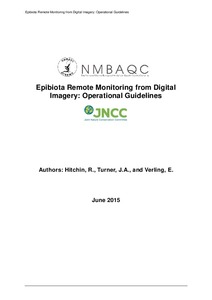| dc.contributor.author | Hitchin, R. | |
| dc.contributor.author | Turner, J.A. | |
| dc.contributor.author | Verling, E. | |
| dc.date.accessioned | 2019-03-03T19:21:29Z | |
| dc.date.available | 2019-03-03T19:21:29Z | |
| dc.date.issued | 2015 | |
| dc.identifier.citation | Hitchin, R., Turner, J.A. and Verling, E. (2015) Epibiota remote monitoring from digital imagery: Operational guidelines. Peterborough, UK, JNCC/NMBAQCS, 24pp. DOI: 10.25607/OBP-413 | en_US |
| dc.identifier.uri | http://hdl.handle.net/11329/866 | |
| dc.identifier.uri | http://dx.doi.org/10.25607/OBP-413 | |
| dc.description.abstract | There is increasing recognition that the effective acquisition and interpretation of underwater
video and still image data for biodiversity is growing in importance. Numerous organisations
(e.g. Statutory Nature Conservation Bodies (SNCBs), Inshore Fisheries Conservation
Authorities (IFCAs), environmental consultancy agencies, industry and academic institutes)
are now engaged in this work for a variety of different purposes, including:
Marine habitat mapping of physical seabed habitats and features in support of a
variety of national and international initiatives, e.g. the Marine Environmental Mapping
Programme (MAREMAP), Integrated Mapping For the Sustainable Development of
Ireland's Marine Resource (INFOMAR) and Mapping European Seabed Habitats
(MESH).
Characterisation of epifaunal attributes of seabed habitats and features e.g. in
support of the Marine Strategy Framework Directive, Water Framework Directive,
designation of Marine Protected Areas (European and National), marine development
applications and licensing.
Monitoring trends in seabed habitat features and their associated epibiotic
communities, e.g. in support of monitoring the effectiveness of management
measures implemented to achieve given conservation objectives within MPAs and
also to assess and monitor predicted impacts for given marine developments and the
effectiveness of mitigation measures implemented.
The guidelines in this document provide a summary of current best practice for the
acquisition of video and stills imaging of benthic substrata and epibenthic species to ensure
that data collected are fit for purpose in relation to the needs and requirements of a survey.
These guidelines form part of the epibiota component of the NMBAQC scheme, reporting to
HBDSEG (Healthy and Biologically Diverse Seas Evidence Group) under the UK’s Marine
Monitoring and Assessment Strategy (UKMMAS). | en_US |
| dc.language.iso | en | en_US |
| dc.publisher | Joint Nature Conservation Committee (JNCC)/ NMBAQCS | en_US |
| dc.subject.other | Underwater photography | en_US |
| dc.subject.other | Video imagery | en_US |
| dc.subject.other | Interpretation | en_US |
| dc.title | Epibiota Remote Monitoring from Digital Imagery: Operational Guidelines. | en_US |
| dc.type | Report | en_US |
| dc.description.status | Published | en_US |
| dc.format.pages | 24pp. | en_US |
| dc.description.notes | Superceded by: http://dx.doi.org/10.25607/OBP-414 | |
| dc.description.refereed | Refereed | en_US |
| dc.publisher.place | Peterborough, UK | en_US |
| dc.subject.parameterDiscipline | Parameter Discipline::Biological oceanography::Biota abundance, biomass and diversity | en_US |
| dc.description.currentstatus | Current | en_US |
| dc.description.sdg | 14.A | en_US |
| dc.description.eov | Benthic invertebrate abundance and distribution | en_US |
| dc.description.bptype | Best Practice | en_US |
| dc.description.bptype | Guide | en_US |
| obps.contact.contactemail | Hayley.Hinchen@jncc.gov.uk | |
| obps.resourceurl.publisher | http://www.nmbaqcs.org/media/1591/epibiota_operational_guidelines_final.pdf | en_US |
 Repository of community practices in Ocean Research, Applications and Data/Information Management
Repository of community practices in Ocean Research, Applications and Data/Information Management
